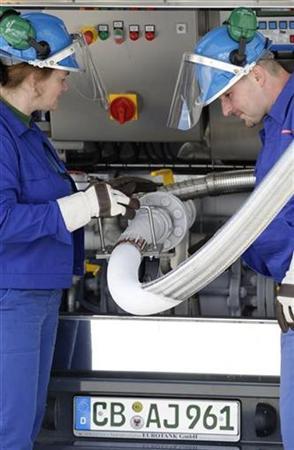Date: 06-Mar-09
Country: US
Author: Timothy Gardner and Bruce Nichols - Analysis
Costs To keep U.S. Carbon Storage From Coal Elusive Photo: Hannibal Hanschke

Vattenfall's CO2-free power plant is a pilot project for carbon
capture and storage (CCS) - the first power plant in the world that will
take the toxic emissions from coal and bury them deep in the ground.
Photo: Hannibal Hanschke
NEW YORK/HOUSTON - Capturing carbon emissions from coal-fired power plants,
the biggest U.S. source of the main greenhouse gas, is unlikely to play a
big role in President Barack Obama's immediate plans to slow global warming,
despite billions of dollars in incentives.
Obama's economic stimulus package contained $3.4 billion for the Department
of Energy's office of fossil fuel, much of which is slated for development
of carbon capture and storage, the fancy name for trying to store emissions
of carbon dioxide permanently underground.
And he wants to join the country with the rest of the developed world in
setting mandatory carbon limits. His short-term goal would cut emissions to
1990 levels by 2020.
But many experts say burying carbon from coal-fired power plants will still
be in its infancy for years beyond 2020.
"(Carbon capture) is certainly not going to be near term. It's more mid-term
to long-term because the technology hasn't caught up with us yet," said Bill
Durbin, head of global power research at consulting firm Wood Mackenzie Ltd.
Development of the technology has been slow, especially after the Bush
administration abandoned FutureGen, a $2 billion plan that sought to join
business and government to fund test storage from a large coal-fired plant.
Burying carbon dioxide from power-plant coal is costly because it requires
the addition of equipment to siphon the gas from a huge volume of emissions.
LOW-HANGING FRUIT
Due to the economic crisis, early efforts likely will focus on lower-cost
targets such as oil refineries, gas processing plants and ethanol
distilleries, which emit purer, easier-to-capture streams of carbon dioxide,
experts predict.
"Those are low-hanging fruit that could be adopted quite quickly," said
Sally Benson, director of Stanford University's Global Climate and Energy
Project. "Having a clear carbon policy will help stimulate the technology
that will probably be in those areas that are most economical."
Benson and other experts say carbon allowances in a U.S. cap and trade
program would have to hit $50 to $100 per ton to support building capture
equipment at coal-fired plants.
That could push power bills up 20 percent, and more in coal-dependent
regions. Pure streams of the gas could be buried with allowances priced at
$10 a ton, she said. In the European market, prices are currently about $15
a ton.
Capturing the major share of the carbon pollution emitted by burning coal is
more likely a mid-century proposition, as Obama seeks by then to cut
emissions even more - 80 percent.
"It isn't going to happen overnight," said John Grasser, spokesman for the
office of fossil energy at the DOE. "But over the next 10 or 20 years, we're
hopeful that these technologies will become commercially available and
widespread."
The long-term climate goal will not be achieved without storing emissions
from coal, many experts say, because the United States has huge supplies of
the fuel, generates 50 percent of its power from it and, along with
countries like China, is likely to burn more of it in the future.
Even if all the low-cost sources of carbon were buried, solving those
problems alone would do little to slow climate change.
"(Carbon capture and storage) is the only real alternative to go forward, to
deal with both climate change and coal," Howard Herzog of the MIT Laboratory
for Energy and the Environment, told a Houston meeting last month.
To be sure, lessons learned from burying non-coal sources could play an
important role in building confidence and lowering costs so investors will
tackle emissions from coal.
That's an important piece of the puzzle. The amount of money the DOE is
slated to get for carbon capture is about equal to the cost of capturing
carbon at a single coal-burning power plant. "People are not going to make
those investments without more confidence," said Stanford's Benson.
Indeed, high costs could keep widespread development of the storage of
emissions of coal at bay for decades.
"I won't be surprised if we have some of these in place in the 2020 to 2030
decade, but ... it's going to be on the margins, just because it costs so
much," Wood Mackenzie's Durbin said.
(Editing by Jeffrey Jones and Marguerita Choy)
© Thomson Reuters 2009 All rights reserved
